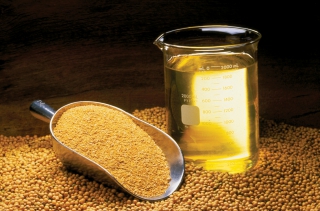
The Benefits of Soybean Oil
10 January 2017Soybean oil has a high smoke point and neutral flavor. Also, new oils such as those made from the low-lin soybean are low in trans fats and make a healthy fat choice for cooks.
By The Soyfoods Council
There are currently four kinds of soybean oil on the market:
- Regular soybean oil (aka “vegetable oil,” and available at retail, in foodservice and for commercial food applications)
- Hydrogenated soybean oil (primarily used in commercial applications)
- Partially hydrogenated soybean oil (shortenings, margarines, fryer oils, commercial ingredient)
- New low- or no-trans fat soybean oils (primarily foodservice and commercial applications, not generally available at retail)
Helpful Information for Cooking with Soybean Oil
Soybean oil is one of the most common and versatile edible oils in the world. Typically marketed to consumers as “vegetable oil,” soybean oil accounts for 75 percent of all vegetable fat and oil consumed in the US. It is made by refining the whole soybean, either by pressing or chemical extraction, a process that leaves soy flakes as a valuable by-product.
What makes soybean oil such a popular choice is that it has so many attractive and beneficial qualities:
- Light color
- Neutral flavor and aroma
- Very high smoke-point (450 degrees F.)
- Ample supply
- Readily and reliably available
- Cost-effective
- High in unsaturated fats
- Contains both essential fatty acids needed to sustain human life
- Excellent source of Vitamin E
- Naturally free of cholesterol and trans fats
Soybean oil’s high smoke point and neutral flavor make it an excellent oil for frying, grilling and sautéing. Its neutral sensory qualities (flavor, color and aroma) also make it ideal for salad dressings, marinades, and batters. Food manufacturers also use lecithin, a naturally occurring component of soybean oil, as an emulsifier, stabilizer and anti-oxidant in a wide range of products.
 Hydrogenated Oils
Hydrogenated Oils
Because soybean oil is rich in unsaturated fats, it has a relatively short shelf-life. As with other unsaturated vegetable oils, soybean oil can be hydrogenated or partially hydrogenated to make it more stable. Adding hydrogen changes the oil from a liquid to a solid (full hydrogenation) or semi-solid fat (partial hydrogenation). Partially hydrogenated soybean oil, in particular, is used broadly in margarines, shortenings, baked products, baking mixes and many other manufactured foods.
These hydrogenated soybean oils retain most of the beneficial qualities of the regular liquid oil: neutral flavor, color and aroma, high smoke point, unsaturated fatty acids, lecithin, Vitamin E, and no cholesterol. And, when fully hydrogenated, they also remain free of trans fats. Partial hydrogenation, however, creates trans fats. This is true for any kind of vegetable oil, not just soybean oil.
New research tells us that trans fats increase the “bad” cholesterol and decrease the “good”, which makes them a serious risk factor for heart disease. More serious, experts say, than saturated fats. Starting in January, 2006, the Food & Drug Administration is requiring all food manufacturers to include trans fats on their nutrition facts labels. Consequently, many manufacturers are looking for alternatives to partially hydrogenated oils—soybean oils and others—that have low- or no trans fats per serving AND low or no saturated fats.
New Reduced-Trans and No-Trans Fat Oils
The soybean industry has developed new soybean oils that function like partially hydrogenated oils but have extremely low or no levels of trans fats. And, unlike some other low- or no-trans fat oils, these new soybean oils remain virtually free of saturated fatty acids.
These new oils are made either by refining soybean oil from a speciallybred variety of soybean (a “low-lin” bean that is low in linolenic acid and therefore does not require hydrogenation) or by treating regular soybeans to a process called interesterification which creates a shortening-like fat that perform like a partially hydrogenated shortening, but without hydrogenation and thus, without the high levels of trans fats.
“Low-lin” soybean oils are excellent for pan-frying, sautéing, deepfrying, and a wide variety of manufactured foods. The more shortening-like interesterified soybean oils are used in baking applications like cookies and pastries, as well as for deep-fat frying. Confectioners also use interesterified soybean oils in candy coatings.
As more of these soybean oil solutions to trans fat are commercialized, the amount of partially hydrogenated oils used in our foods will drop significantly.
Photos courtesy of The Soyfoods Council and SafeBee.com.
